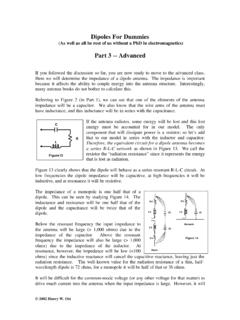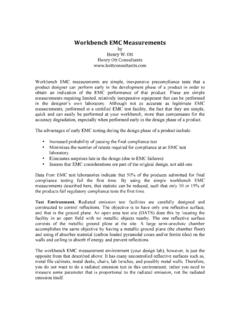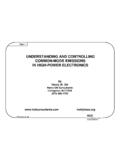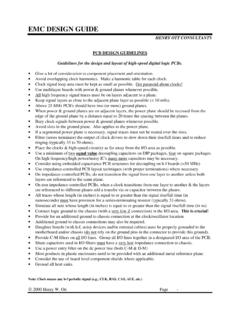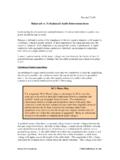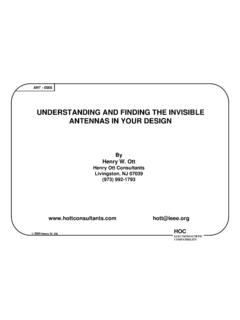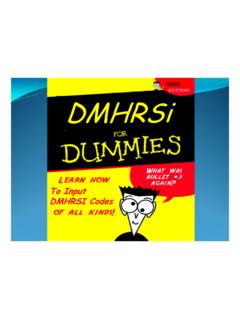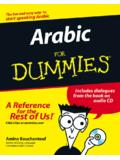Transcription of Dipoles For Dummies, Part 1 -- Basic
1 Dipoles for dummies , part 1 -- Basic (As well as all he rest of us without a PhD in electromagnetics). Dipoles for dummies is a simple, insightful, and intuitive discussion of how a dipole antenna works, and how the operation is related to the common-mode radiation from a product. Once the antenna theory is understood, controlling the common-mode radiation becomes a lot easier task. Readers will end up with a better understanding of dipole antenna theory, and know why understanding a dipole antenna is so important to EMC engineering. All of this is accomplished without using mathematics or writing a single equation.
2 I'm sure this dissertation would make my old college Electromagnetic Fields professor roll over in his grave. An understanding of some Basic antenna theory would be helpful for all engineers, especially those involved in EMC. After all, if a product radiates (or is susceptible to RF. energy) it is an antenna even if you call it something else -- such as a microprocessor, an IC, a PCB, a power cord, or an RS-232 cable. A dipole is a very Basic antenna structure consisting of two straight collinear wires as depicted in Figure 1. The first thing to notice about a dipole is that it has two parts, hence the term di.
3 In its name. How can we explain the fact that you can drive current into a dipole when the ends are open circuited, and we, therefore, do not Figure 1 have a closed loop? The simplest way to resolve this seeming dilemma is to consider the parasitic capacitance between the two arms of the antenna as the return current path, as shown in Figure 2. At high frequency this capacitance will represent a low impedance. Current through this uncontrolled parasitic capacitance represents radiation. Therefore, a dipole antenna requires two parts in order to radiate and the amount of radiation will be proportional to the dipole current.
4 Note also from Figure 2 that, a dipole does not require a ground to work. A good analogy is to consider what happens Figure 2. when we clap our hands. Clapping launches an acoustic wave, whereas a dipole launches an electromagnetic wave. It takes two hands to clap, just like it takes two arms for a dipole antenna Reference Plane to radiate. What about a monopole, does it only need one part to Figure 3 radiate? The answer is no, a monopole needs two parts. A monopole is just a dipole in disguise. The 2002 Henry W. Ott second part is normally a reference plane located below the one arm as shown in Figure 3.
5 The current path in this case is through the parasitic capacitance from the one arm of the monopole to the reference plane as shown in Figure 3. If you do not provide the reference plane (which is the second part of the antenna) the antenna will find something to work against, usually the largest metal object around. Note, that the reference plane does not have to be a plane. Any metal object with capacitance to the monopole will do just fine, regardless of its shape. Other examples of monopole antennas configurations are shown in Figure 3A. Reference Plane Reference Cone Reference Sleeve Figure 3A.
6 Note, that even in the case of the monopole no ground is needed to operate. Referring to our clapping analogy again, consider the case where you are asked to clap with one hand in your pocket. You take your free hand and find something to clap against such as your desk, a table, or wall, that's exactly how a monopole works. Therefore, the way to make an antenna (dipole or monopole) is to have an RF potential between two pieces of metal. The capacitance between the two pieces of metal will then provide the current return path. The way to prevent the radiation is to connect the two halves of the antenna together so that they are at the same potential and, therefore, cannot radiate since then there will be no current through the parasitic capacitance.
7 By the way, it does not mater what potential the halves are at, as long as there is not a potential difference between them. Returning to the clapping analogy, if you put your two hands together and wrap duct tape around them (equivalent to holding the two arms of the dipole at the same potential), you no longer can separate your hands, and clap. So what does all of this have to do with EMC, you ask? It turns out quite a bit! Let's consider a simple product in a metallic enclosure with a single cable attached as shown in Figure 4. To make it more interesting let's assume that we put the product on a 2002 Henry W.
8 Ott rocket and launched it into space so that it is now orbiting the earth. I. think under these circumstances we can bypass a discussion of how we Cable should ground the product! However, if there is a potential difference between the chassis and the cable we have produced a monopole antenna (the cable is the arm Ckt. (pole) of the antenna and the chassis is the reference plane) and the cable will radiate. This potential difference is often referred to as the Chassis common-mode voltage. Figure 4 Since we do not want a difference of potential to exist between the cable and chassis, how we connect the circuit to the chassis becomes very important.
9 The internal circuit reference (often called circuit ground ) should be connected to the chassis as close to where the cable terminates on the circuit as possible, in order to minimize the voltage between the two. This connection must provide a low impedance at RF frequencies. Any impedance between the circuit reference and the chassis will produce a voltage drop and will cause the structure to radiate. The circuit reference (circuit ground) to chassis connection is often made with poorly placed metal stand-offs and can be of considerable impedance. Seldom is the connection optimumized for EMC purposes.
10 This connection, and how it is made is critical to the EMC performance of the product. A second possibility to reduce the cable radiation is to place capacitors between all the cable conductors (even the one we call ground) and the chassis in order to short out the RF potential between the cable and chassis. Thirdly, we could use a common-mode choke (ferrite core) on the cable to raise the cable common-mode impedance, and hence reduce the cable current produced by the common- mode voltage that exists between the chassis and the cable. Last, but not least, we could shield the cable and terminate the shield properly (360.)
